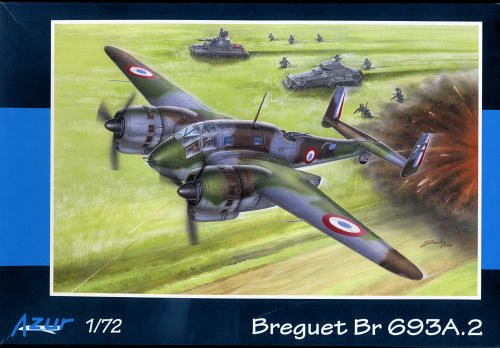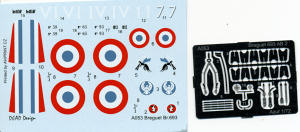
Azur 1/72 Breguet Br.693A.2
| KIT #: | A053 |
| PRICE: | $30.55 from GreatModels |
| DECALS: | Two options |
| REVIEWER: | Scott Van Aken |
| NOTES: |

| HISTORY |
The 690 had begun life in 1934 as Breguet's response to the same strategic fighter aircraft specification as the eventual winner, the Potez 630. Both were twin-engine monoplanes with twin tailplanes, powered by Hispano-Suiza 14AB radial engines of contemporary design and performance. Breguet considered the weight limits of the specification - requiring a twin-engine, three-man aircraft to be lighter than 3,000 kg/6,600 lb (later 3,500 kg/7,700 lb) - to be overly restrictive and ignored them. Instead, the design was advertised as particularly versatile, with reconnaissance, ground attack and level bombing derivatives proposed that required no structural changes. Unsurprisingly, Breguet lost out in the competition to Potez, but confident in the 690's potential, nevertheless began building a prototype on its own funds.
Although it had kept informed about foreign developments with dive bombers in the early 1930s, the French Air Force did not decide to acquire modern ground-attack aircraft before 1937. Engineless for nearly a year, the 690-01 prototype finally flew on 23 March 1938, and displayed such promise that 100 two-seat attack bomber versions known as the Breguet 691 AB2 were ordered in June 1938, an order which was eventually doubled. For the ground-attack role, the 691's equipment included a 20 mm cannon and a pair of 7.5 mm (.295 in) machine guns firing forward, as well as an internal bomb rack that could be used in a shallow dive attack and was typically loaded with eight 50 kg (110 lb) bombs. Rear defense was provided by one flexible 7.5 mm (.295 in) machine gun, while a fixed, rearward-firing weapon of the same type was fitted under the fuselage to discourage low-flying fighters or ground fire from behind. A set of armour plates protected the crew, and the fuel tanks had rudimentary self-sealing capability, but this protection proved insufficient in combat.
Breguet established an assembly line with remarkable speed: the first production aircraft flew less than a year after being ordered, and was in service before the end of 1939.
As with the Potez 630, the Bre 691 was beset with engine difficulties. Hispano-Suiza had decided to concentrate on its V12 liquid-cooled engines and the 14AB engine was unreliable. The French authorities decided to order a new version, the Bre 693 powered by Gnome-Rhône 14M radials. Apart from the changed engines, which were of slightly smaller diameter, the two types were virtually identical. Orders for the Bre 691 were switched to the new type and more than 200 of the latter had been completed by the time of France's defeat.
Late production versions of the Bre 693 introduced propulsive exhaust pipes that improved top speed by a small margin as well as, according to some sources, a pair of additional machine guns in the tail of each engine nacelle. Belgium ordered 32 licence-built copies but none were completed before the Belgian collapse.
| THE KIT |
 This
is one of the more recent MPM/Azur kits and like all of their more recent
offerings is very nice. Well engraved detailing and an injected plastic sprue
are now standard stuff. This one also included two superbly done resin
Gnome-Rhone radials and a small etched fret or harnesses, bomb fins and a gun
sight with a few other bits. The cockpit includes nicely raised detail on the
instrument panel and side consoles. A control stick, seat, and rudder pedals are
also included. There is quite a bit of detail in the fuselage behind the pilot
as one can see into the gunner's compartment where various radios and his seat
are located.
This
is one of the more recent MPM/Azur kits and like all of their more recent
offerings is very nice. Well engraved detailing and an injected plastic sprue
are now standard stuff. This one also included two superbly done resin
Gnome-Rhone radials and a small etched fret or harnesses, bomb fins and a gun
sight with a few other bits. The cockpit includes nicely raised detail on the
instrument panel and side consoles. A control stick, seat, and rudder pedals are
also included. There is quite a bit of detail in the fuselage behind the pilot
as one can see into the gunner's compartment where various radios and his seat
are located.
The kit includes a full load of bombs and there is a clear bomb bay door, something I find a bit unusual. There are two designs one that looks as if it should be a normal bomb bay and another with a plethora of windows as if it to be used for reconnaissance. The instructions only reference the recce bay doors, which makes it quite confusing. Were it me, I'd use the standard bomb bay doors. The rest is pretty standard with the engine trapped between cowling halves and the wings fitting onto root size tabs on the fuselage.
 Four aircraft
are featured on the decal sheet, differing only in serial number and unit
marking. French planes were not really painted to a standard camouflage design
and so there was a lot of variation. The colors were all the same and there are
several paint companies that can provide French WWII camouflage colors. Azur
lists a variety of Gunze paints for this purpose. The decal sheet is nicely
printed and like all MPM/Azur kits, should be very thin and work well with
weaker setting solutions such as Microsol.
Four aircraft
are featured on the decal sheet, differing only in serial number and unit
marking. French planes were not really painted to a standard camouflage design
and so there was a lot of variation. The colors were all the same and there are
several paint companies that can provide French WWII camouflage colors. Azur
lists a variety of Gunze paints for this purpose. The decal sheet is nicely
printed and like all MPM/Azur kits, should be very thin and work well with
weaker setting solutions such as Microsol.
| CONCLUSIONS |
Up until now, the only mass market 693 in 1/72 was the old Heller kit. This is one of their first offerings and so it lacking in finesse and detail. This one pretty well puts that kit to pasture.
| REFERENCES |
http://en.wikipedia.org/wiki/Breguet_693
May 2011 You can get this and
many other neat kits and accessories at
GreatModels
If you would like your product reviewed fairly and quickly, please
contact
me or see other details in the
Note to
Contributors.